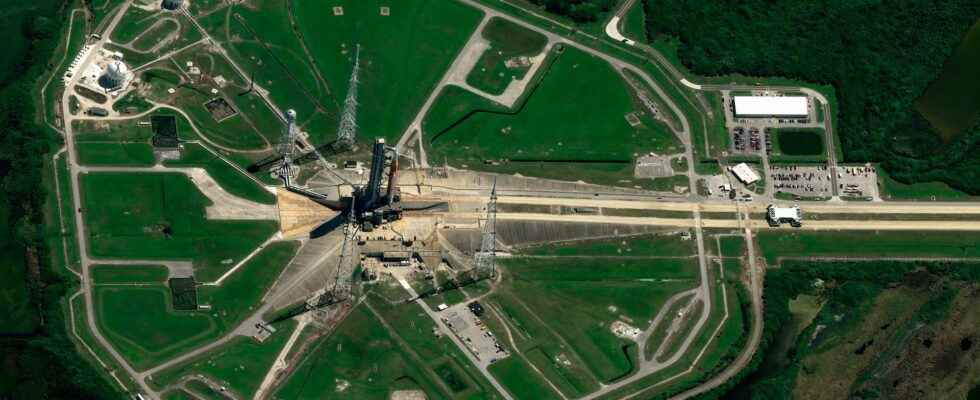You will also be interested
[EN VIDÉO] Watch what the Artemis mission launches will look like At the end of 2021, NASA’s new heavy launcher, the SLS (Space Launch System), will launch the first Artemis I mission to the Moon. This is what its first flight will look like.
After being transferred to its launch pad (roll out, in English), Airbus’ Pléiades Neo satellite acquired a series of satellite images of the launcher SLS (Space Launch System) and Orion vehicle of the Nasa with a resolution of only 30 centimeters and a high level of contrast. Developed by Airbus DS, Pléiades Neo is a constellation of four satellites, two of which are currently in orbit. They were launched in April and August 2021.
This constellation has several remarkable features, including that of offering images of the ground with a resolution of 30 centimeters per pixel over a (mowed) surface of 14 kilometres. A record for this image quality. This explains why it is possible to see on the same picture, the 39A launch pad, the assembly building (Vehicle Assembly Building or VAB), and the 6.4 kilometer road between them. You can also see the crawler (tracked transporter) used to drive the launcher from the VAB to its launch location.
In pictures, the first outing of NASA’s giant SLS rocket
Article by Nathalie Mayer published on 03/18/2022
NASA released yesterday its Space Launch System (SLS) from the hall in which it was assembled at the Kennedy Space Center in Cape Canaveral (Florida, USA). The powerful launcher that will carry the next human missions to the Moon.
Yesterday, Thursday, March 17, 2022, at the end of the afternoon — around 6 p.m. local time — the Space Launch System (SLS) from NASA — the powerful launcher whose mission will be to bring astronauts on the moon — has finally left the hall of the Kennedy Space Center in Cape Canaveral (Florida, USA) in which it was assembled. Head to launch pad 39B, a little over six kilometers away.
Six kilometers to the launch pad
Six kilometers is not much. But for a 98.3 meter high SLS launcher, harnessed in a vertical position on its “crawler”this kind of mythical tractor which had been imagined within the framework of the Apollo program and whose speed point does not exceed 1.5 kilometers per hour, it’s quite an adventure.
Reflecting in the waterways of Kennedy Space Center, NASA’s Space Launch System rocket is headed to LC-39B, seen with the neighboring LC-39A in the background. pic.twitter.com/vmp16SV9AG
— John Kraus (@johnkrausphotos) March 18, 2022
It will thus have taken no less than 11 hours of a cautious expedition to carry the SLS launcher and its more than 1,300 tons – with only its boosters loaded powder — on the no shooting which it could be launched from June 6th. It will be based on the results of the tests he will now take for the next two weeks.
This is the big day ! Nasa’s powerful SLS launcher finally shows itself tomorrow in full
Preparation for the maiden flight of the SLS, NASA’s launch vehicle to return to the Moon, continues. Tomorrow, he will be transferred to his launch pad with the vehicle on board. But only for testing. Its launch for a flight around the Moon could take place in June or July.
Article of Remy Decourt published on 03/16/2022
The return of the Americans to the Moon is being actively prepared. The delays in the construction of the very powerful and very large SLS launcher are today a bad memory. All the lights seem to be green despite the delay on the initial schedule which provided for a first flight in 2017!
The launcher, with the Orion vehicle on board for the Artemis 1 mission, is currently in its assembly building (Vehicle Assembly Building or VAB), the same one used by space shuttles for their assembly and preparation. After a final review, NASA authorized the installation of the launcher on launch pad 39B at the Kennedy Space Center, located several kilometers from the VAB. The operation is scheduled for March 17 and will be broadcast live on Nasa.tv.
This transfer to the launch pad does not mean that the launch is near! Before launching Artemis 1, NASA has planned several weeks of checks and tests that will end with a complete repetition of the countdown, that is to say the filling of the main stage in hydrogen and oxygen liquids until the fire of the four RS-25 engines which, of course, will not take place.
Uncertainty on the launch date
This dress rehearsal should begin on April 3 with the filling operations of the main floor tanks. Assuming all went well, NASA would be considering a launch in June or July. The option of an earlier launch, when window of shooting which will open on May 7 and will close on May 21, is also under consideration.
At the end of this test and its analysis, NASA should be able to announce the launch date.
Support an editorial team committed to popularizing science on Patreon!
Our mission ? Return the knowledge accessible to everyone.
We produce our own articles, investigations and reports every day, all on a human scale. Support us in this approach and this ambition.
Subscribe to Futura on Patreon!
Two subscription plans are offered to you with the following advantages:
- ” Futura ad-free »: get guaranteed ad-free access to the entire site for €3.29/month (+VAT).
- ” I participate in the life of Futura »: in addition to access without advertising, take part in the life of our independent media (votes, new content, surveys, etc.) for €6.29/month (+VAT).
Interested in what you just read?
